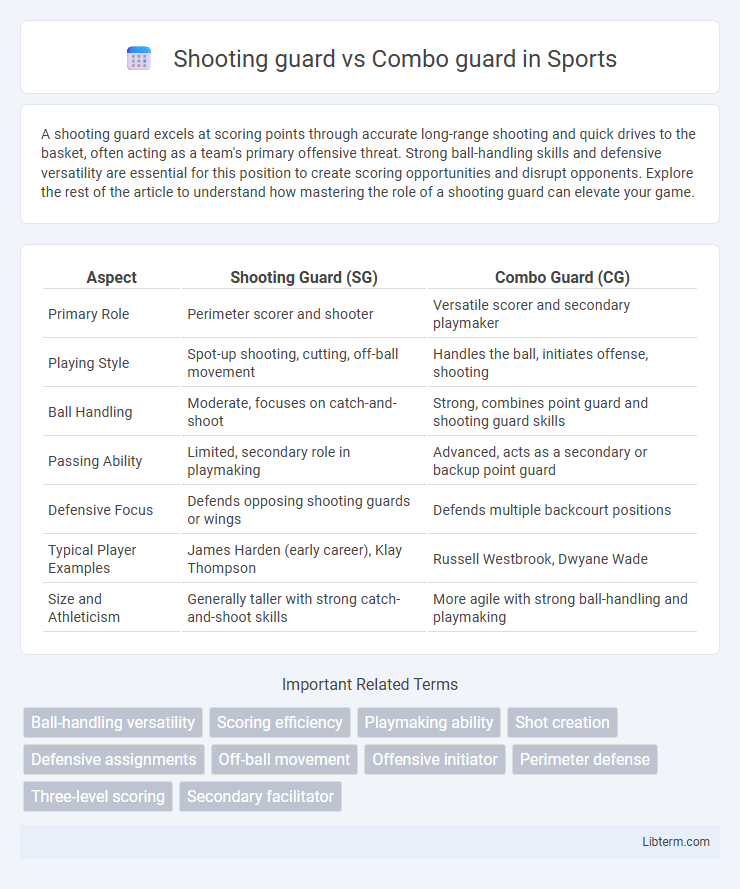A shooting guard excels at scoring points through accurate long-range shooting and quick drives to the basket, often acting as a team's primary offensive threat. Strong ball-handling skills and defensive versatility are essential for this position to create scoring opportunities and disrupt opponents. Explore the rest of the article to understand how mastering the role of a shooting guard can elevate your game.
Table of Comparison
| Aspect | Shooting Guard (SG) | Combo Guard (CG) |
|---|---|---|
| Primary Role | Perimeter scorer and shooter | Versatile scorer and secondary playmaker |
| Playing Style | Spot-up shooting, cutting, off-ball movement | Handles the ball, initiates offense, shooting |
| Ball Handling | Moderate, focuses on catch-and-shoot | Strong, combines point guard and shooting guard skills |
| Passing Ability | Limited, secondary role in playmaking | Advanced, acts as a secondary or backup point guard |
| Defensive Focus | Defends opposing shooting guards or wings | Defends multiple backcourt positions |
| Typical Player Examples | James Harden (early career), Klay Thompson | Russell Westbrook, Dwyane Wade |
| Size and Athleticism | Generally taller with strong catch-and-shoot skills | More agile with strong ball-handling and playmaking |
Introduction: Defining Shooting Guard and Combo Guard
A shooting guard primarily excels in perimeter scoring, utilizing strong shooting skills and off-ball movement to create points. Combo guards blend the attributes of both shooting guards and point guards, bringing versatility in playmaking and scoring. This hybrid role demands proficiency in ball handling, court vision, and long-range shooting to adapt to multiple offensive strategies.
Key Roles and Responsibilities
Shooting guards primarily focus on scoring through perimeter shooting, slashing to the basket, and playing tough defense on opposing wings, excelling in three-point shooting and creating scoring opportunities. Combo guards blend the responsibilities of both point guards and shooting guards, managing ball handling, playmaking, and scoring, often adapting between facilitating offense and serving as a secondary scorer. Both roles require strong defensive skills, but combo guards typically have greater playmaking duties and versatility in orchestrating offensive sets.
Core Skill Sets Compared
Shooting guards excel in perimeter shooting, off-ball movement, and catch-and-shoot scenarios, emphasizing three-point accuracy and creating scoring opportunities from the wings. Combo guards combine the ball-handling and playmaking abilities of point guards with the scoring and shooting skills of shooting guards, offering versatility in both facilitating offense and attacking the basket. While shooting guards prioritize shooting and scoring efficiency, combo guards balance scoring with advanced dribbling, passing, and decision-making under pressure.
Scoring Techniques and Shot Selection
Shooting guards excel in mid-range jumpers, catch-and-shoot threes, and off-the-dribble pull-ups, relying on precision and quick release for effective scoring. Combo guards combine the shooting guard's outside scoring with point guard abilities, using penetration to create shots and a wider variety of mid-range and three-point attempts. Shot selection for shooting guards tends to prioritize open looks from the perimeter, while combo guards strategically mix isolation drives and spot-up shooting to exploit defensive mismatches.
Playmaking and Ball-Handling Duties
Shooting guards primarily focus on scoring while maintaining solid ball-handling skills to support offensive plays, often acting as secondary playmakers. Combo guards blend the roles of point guards and shooting guards, taking on significant playmaking responsibilities and advanced ball-handling duties to facilitate team offense. Their versatility enables them to initiate plays, create scoring opportunities, and adapt to various defensive pressures effectively.
Defensive Capabilities and Assignments
Shooting guards primarily focus on perimeter defense, guarding opposing wing players and preventing outside scoring while using lateral quickness to stay in front of shooters. Combo guards exhibit versatility by defending both point guards and shooting guards, requiring agility to switch effectively between ball handlers and scorers in pick-and-roll situations. Defensive assignments for combo guards often include disrupting passing lanes and providing help defense, leveraging their hybrid skill set to adapt to various offensive threats.
Versatility and Adaptability on the Court
Shooting guards excel in perimeter scoring and off-ball movement, while combo guards combine these skills with point guard responsibilities such as playmaking and ball handling. The adaptability of combo guards allows them to shift seamlessly between scoring and facilitating, making them highly versatile in offensive schemes and defensive matchups. This dual capability enhances team dynamics by providing flexibility in rotations and strategic adjustments during games.
Impact on Team Strategy and Lineup
The shooting guard primarily enhances perimeter scoring and spacing, allowing teams to stretch defenses and create isolation opportunities, while the combo guard offers versatility by combining scoring with playmaking, enabling dynamic offensive shifts and improved ball distribution. Teams employing a shooting guard often rely on traditional roles with defined scoring responsibilities, whereas lineups featuring a combo guard benefit from increased adaptability, facilitating seamless transitions between point guard and shooting guard duties during gameplay. This strategic flexibility influences lineup construction, as combo guards allow coaches to optimize rotations based on matchup advantages and offensive flow, ultimately impacting tempo and scoring efficiency.
Notable Shooting Guards vs Famous Combo Guards
Notable shooting guards such as Michael Jordan, Kobe Bryant, and Dwyane Wade excel in scoring, perimeter shooting, and defensive prowess, defining the traditional two-guard role. Famous combo guards like Russell Westbrook, James Harden, and Klay Thompson blend point guard ball-handling and playmaking with shooting guard scoring abilities, providing versatile offensive options. The distinction lies in shooting guards focusing primarily on scoring and defense, while combo guards offer a hybrid skill set that adapts to both guard positions effectively.
Choosing the Right Guard for Your Team
Selecting the right guard for your team depends on your offensive strategy and player versatility. A shooting guard excels in perimeter scoring and off-ball movement, providing reliable outside shooting and spacing. Conversely, a combo guard offers flexibility by blending point guard playmaking with shooting guard scoring, ideal for teams needing adaptable backcourt roles.
Shooting guard Infographic

 libterm.com
libterm.com